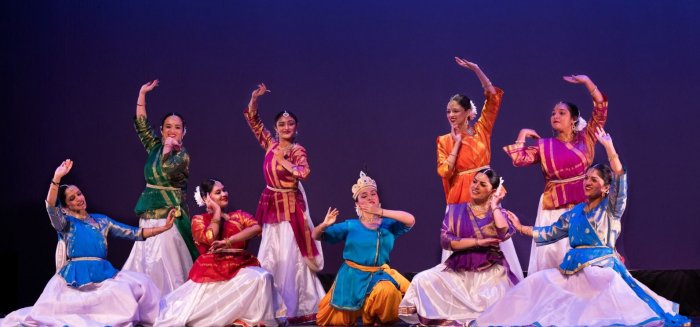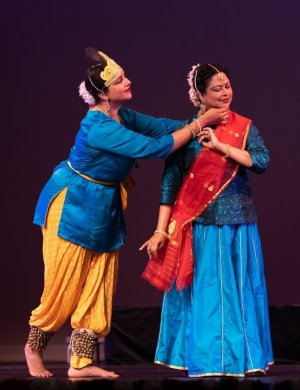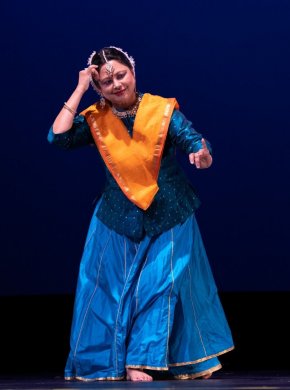
|   |

|   |
A homage to Pt. Birju Maharaj in the San Francisco Bay Area - Shubhra Sinha e-mail: shubhra.sinha@gmail.com Photos: Anubhava June 13, 2023 The passing of Pt. Birju Maharaj left an insurmountable void in the world of Indian classical dance, and music. After the loss of this doyen of dance, Alastair Macaulay, chief dance critic of The New York Times, said, "He also showed that dance was part of something larger: a response to nature and to divinity." Today, leading exponents who continue his legacy, including his family and students around the world, are making sure that the aura of his brilliance will never diminish. Anuradha Nag, the founder and Artistic Director of Tarangini School of Kathak Dance is one of the foremost disciples of Pt. Birju Maharaj. Over the past thirty years, she has hosted him at her home every couple of years, organizing performances by Maharaj-ji and his leading students, with artistes like Ustad Zakir Hussain joining him, and also promoting Maharaj-ji's style, creativity and love of Kathak through dance workshops. Anuradha Nag had her initial training in this art form from Nataraj Parimal Krishna and later from veteran gurus Pandit Birju Maharaj and his foremost disciple Pandit Vijai Shankar. She enhanced her abhinaya under the guidance of Kalanidhi Narayanan. This year, Anuradha celebrated the 30th anniversary of the founding of the Tarangini School of Kathak Dance in the San Francisco Bay Area. The school's name and logo was coined by Pt. Birju Maharaj himself, and it was established by Anuradha Nag in 1992 to promote the awareness and preservation of the rich heritage of Kathak. This year, her momentous two-day show Samanaya "coming together", was dedicated to the memory of Pt. Birju Maharaj. Each evening, the show presented three parts of a lovely repertoire. The first part was Krishna Varnana, featuring the students of Tarangini, who described the various attributes of Lord Krishna through Kathak, choreographed on a selection of memorable songs. While Anuradha always created her own items for the school's shows, this time she chose a few of Maharaj-ji's poems and music compositions as a tribute to him. After the intermission, Anuradha and Tarangini's senior dancers presented Krishna Viraha Sphurthi, a company production that explored three phases of life in Vrindavan: from the joyful moments of togetherness with Krishna, to the sorrow and viraha experienced after he left Vrindavan, and ending with the ultimate liberation of Radha and the gopis in a Krishna Samadhi, achieving a state of pure bliss through their immersion in bhakti. The first evening concluded with Anubandhana, uniting three lineages and gharanas of Kathak. Anuradha had invited guest artistes Ragini Maharaj, Durgesh Gangani and Vishal Krishna to showcase the distinctiveness of each gharana while emphasizing their relationships and harmony. Day two featured performances by two luminaries of the Lucknow gharana of Kathak: Saswati Sen and Mamta Maharaj. Samanaya, the first section of the evening's repertoire, thrilled the audience with the visual experience of watching a variety of Tarangini students - those who had just ventured into 'ta-thei-thei-tat', and across their Kathak learning journey, to senior dancers who are now at the threshold of joining the Tarangini production company. The beauty of their dancing, attention to taal, and the focus on the precision of hastaks and movements, illustrated the effectiveness of Anuradha's teaching prowess and her focus on the kavyaktama (poetic elegance) of Kathak, as developed by Pt. Birju Maharaj. With exquisite choreography on bandishes like "Aaj Shyam", and "Shyam Sundar Nandgopal", amongst others composed by Pt. Birju Maharaj, and "Saaware ke rang," a famous bhajan by Meerabai and set to music by the late Pandit Ravi Shankar for the film Meera, Anuradha's students elicited applause at the sharp arrivals at sam numerous times in each item. The end of Samanaya was especially poignant. Anuradha's daughters - Anupriya and Anumita Nag - performed the Kalavati Tarana, which was released in 1985 in 'Splendours of the Kathak', the very first LP of pieces composed and sung by Pt. Birju Maharaj himself. These two young torchbearers made this anniversary event noteworthy, as we observed the heritage of Pt. Birju Maharaj's Kathak being passed on to the next generation.  Krishna & Gopis in a vibrant and joyful mood in Vrindavan In the next showcase, the company production Krishna Viraha Sphurthi, featured Anuradha and her accomplished senior students. Anuradha Nag started this part of the performance with a tribute to Pt. Birju Maharaj, with a Krishnashtakam sung by him "Bhaje vrajaika maṇḍanaḿ". Maharaj's voice reverberated through the auditorium. Having trained under such phenomenal gurus, Anuradha's emotive mastery drew the audience in, setting the mood for immersion into Krishna. Next, setting the vibrant, joyful mood in Vrindavan when Radha and the gopis frolic with Krishna, through the lilting Ashtapadi by Bindadin Maharaj "Niratat Dhang", the precision and tayyari of the Tarangini students set the stage aglow and enraptured the audience. Continuing to envelop the spectators in this Krishna inspired ebullience, the flow into raag Kedar with Kanha re, and a fast Tarana illustrated Anuradha's creativity in melding this traditional chota khayal with tukra, parans and ladis seamlessly. The dancers portrayed the different loves of Krishna, from Radha and the gopis in rapture, mesmerized by Krishna's spellbinding flute, playing hide-and-seek with Krishna, immersed in Raas leela, to mother Yashoda with an adorable young dancer portraying Balgopal, the Kanha. This storytelling through dance, a core aspect of Kathak, and all Indian classical dance forms, was brought to the fore throughout the evening's performances.  Mahika Ranganekar and Anuradha Nag as Krishna and Radha Krishna Viraha Sphurthi then moved into the pangs of separation when Krishna left Vrindavan. Based on the vast collection of poems Sursagar, by the great poet Surdas, Anuradha's musical compositions and choreography poignantly explored the emotional bereftness of all of Vrindavan's beings due to Krishna's move to Mathura. Krishna's conversation with Udho, Udho's journey to Vrindavan to convince Radha and the Gopis to explore Nirgun Bhakti, and the reaction of the forlorn Vrindavan residents was conveyed through the sufi qawwali "Kanhaiya yaad bhi hai kuch hamari." Maa Yashoda, who had lovingly raised Krishna as her own child, asked Udho to convey her heartache to Devaki. Radha also clings to Krishna's flute that he left behind in Vrindavan, her only remaining physical connection with him, conveying her melancholy. The dance by the Gopis reminiscing about Krishna on "Madhukar Shyaam hamaare chor", was specially unique in its choreography - Anuradha captured the essence of the various types of Krishna relationships - with individual Gopis and a baby Krishna doing Makhan chori (stealing butter), playfully when a young Krishna breaks their earthenware pot on the way to the Yamuna river, in a romantic episode with Krishna as a lover, as a mother Yashoda protecting her naughty child from exasperated Gopis and many more. Then Radha's sorrowful state of viraha was performed by Anuradha Nag herself through the songs "Saajan mera chod gaya", "Dahu disi kau aati biraha", and "Kari gayei thode din ki preet" performed movingly. Udho's return to Mathura further saddened Krishna, who was also in a state of viraha upon hearing the news of a grief stricken Vrindavan, dancing to "Udho mohe Braj bisrat nahi''.  Anuradha Nag as Radha Finally, Radha realized that she and Krishna are in fact one being, one soul. This consciousness, this energy that engulfed her was "Spurthi". Radha was liberated from the bondages of the material world, and finally achieved a true understanding of Krishna's Leela, his divine play. She felt his spiritual presence everywhere, sustaining all of creation, and her own being. Anuradha's portrayal of this perception, and attainment of spirituality through the composition "Hum jo bhi hai, tum kaaran ho" emotionally connected with the audience, moving many to tears. Krishna Viraha Sphurthi ended with the residents of Vrindavan experiencing pure bhakti, at Krishna Samadhi. They came together in a state of bliss in the finale with "Hey Madhava Hey Keshava". This Tarangini production was very obviously an endeavor of reverence and homage to Pt. Birju Maharaj, an ode penned by Anuradha's desire to propagate his dance ethos and to keep his flame burning bright. The thought process, creativity, hours spent in the music recording studio in Calcutta, and months honing the skill of her students in California came forth in this performance, dazzled the audience and was a triumph in showcasing the vastness of the school's impact in propagating the essence and learning of Kathak.  Vishal Krishna, Ragini Maharaj and Durgesh Gangani The final portion of both nights' performances was 'Anubandhana' meaning Continuity and Unity. The first evening showcased the next generation, young artistes from India representing three lineages and gharanas of Kathak. Each gharana has its unique strength, beauty, and intricacies -- but this evening they came together to signify the oneness of Kathak. These three performers were Durgesh Gangani, son of Pt. Jagdish Gangani, one of the senior most gurus of the Jaipur Gharana, and the grandson of Kathak Guru Pt. Sundarlal Gangani; Ragini Maharaj, elder daughter of Deepak Maharaj and granddaughter of Pt. Birju Maharaj of the Lucknow Gharana and Vishal Krishna, the great-grandson of Acharya Pt. Sukhdev Maharaj and grand nephew of Sitara Devi from the Benaras Gharana. Durgesh started with a Shiva Stuti Paran composed by his grandfather Pt. Sundarlal Gangani, followed by a traditional composition in teentaal. His scintillating speed, mastery of taal and sharpness of spins and footwork was a clear illustration of the Jaipur Gharana. Ragini initiated her dance with the beautiful composition 'Ithlati' written by Pt. Birju Maharaj as part of his 'Man Bheetar' release, describing the nature of clouds, thunder, lightning and rain. She followed this with technical compositions in teentaal. Bringing together the lasya and nritta (the lyrical and pure dance aspects) with such grace and charm, Ragini personified the heritage of the Lucknow Gharana that ran in her veins. And Vishal began his performance with a Shiva Kavitt Paran written by Pt. Sukhdev Maharaj, followed by technical compositions of the Banaras Gharana in teentaal. Vishal's wizardry in the special aspects of the Benaras Gharana like the Kathak on the rim of a brass thaali, the swift sprints and the flying leaps, immediately reminded us of his legendary maternal grand-uncle Pt. Gopi Krishna. These short presentations were followed by the trio coming together for a unifying Kathak presentation that brought the three gharanas together. Each of these three young maestros brought the audience to their feet, and left them wanting for more.  Mamta Maharaj and Saswati Sen On the second evening of Tarangini's 30th anniversary celebration, Anuradha Nag kept the Lucknow Gharana's heritage front and center in her homage to Pt. Birju Maharaj, by inviting two luminaries of the Lucknow gharana of Kathak, Mamta Maharaj, daughter of Pt. Birju Maharaj and Saswati Sen, the senior most disciple of Pt. Birju Maharaj to perform. Mamta Maharaj presented Brikuti, a composition written by Maharaj himself - the piece depicted the nuances of Kathak, describing how beautifully every part of the body dances. She followed this unique composition with a technical presentation in taal Dhamaar. Mamta Maharaj's expressive art of abhinaya, technical expertise, and exquisite moves made us all imbibe the taalim she received and has inculcated from her father. Saswati Sen, whom we have seen through the years dancing by his side, presented Shyam Murat, a composition written by Pt. Birju Maharaj nearly 40 years ago. The whole show ended with the convergence of Mamta Maharaj and Saswati Sen in an impromptu, captivating sawal-jawab. The standing ovation they received was joyous for the skills, emotions, grace and acuity presented, but also bittersweet in the nostalgic memories of the maestro. Anuradha Nag, through her 30th anniversary show of the Tarangini School of Kathak Dance, had aimed to present a tribute to and honor the ingenuity and tradition that was embodied by the one and only Pt. Birju Maharaj, and she successfully did just so. From the promotion and preservation of the rich heritage of Kathak through her young students, to the creativity and proficiency showcased in her main production, to presenting the standard bearers of the Gharanas of Kathak, Tarangini's show was a reminder of the genius of her guru, mentor and friend, Pt. Birju Maharaj.  Shubhra Sinha is an exponent of Kathak. Trained under the foremost gurus and doyens of Kathak like Pt. Birju Maharaj, Munna Lal Shukla, Kapila Raj and Anuradha Nag, she has performed extensively in India, UK and the US. She is also a trained Indian classical vocalist. While pursuing her passion for Indian classical music and dance, Shubhra continues to enjoy her profession as a senior executive in strategic marketing at leading enterprise software companies in the US. |